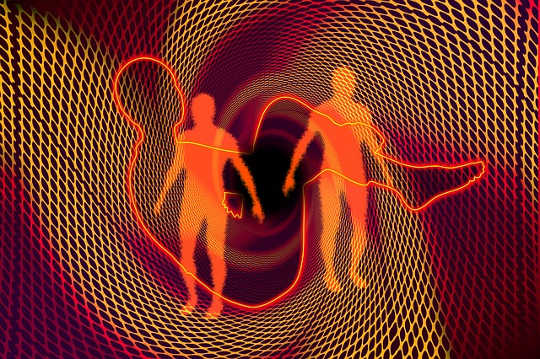 Image by Gerd Altmann from Pixabay
Image by Gerd Altmann from Pixabay
A former fear-of-flying client emailed the following:
What you taught me did wonders. I have no panic at all. It worked so well that I’m wondering if it can help me with my new job. For the first time I’m a supervisor. When someone asks a question and I don’t know the answer, I get extremely anxious. I feel like I’m in over my head. My boss says I’m doing a good job. But, I feel the same when I’m talking to him. I’ve thought about quitting. But, I moved here to take this job, and I can’t handle moving back.
So far this book has focused on panic. Now let’s look at anxiety. What are some of the differences between panic and anxiety? In panic, a person believes their life is threatened and that escape from the threat is impossible. With anxiety, the threat is not life-threatening. Escape is possible, but it has drawbacks: it may involve compromise or some kind of cost or loss. Fortunately, we can apply the same techniques we use for ending panic to ending anxiety.
Self-Regulating The Urge to Escape
When stressed by face-to-face interactions, my client felt an urge to escape. If he had been in a situation where escape was blocked, he would have experienced panic. Since escape was possible in this situation, he did not panic, but he was anxious that he would lose control, the urge to flee would overwhelm him, and he would cut and run. If he did, he would be fired, and his self-esteem would be damaged.
In his previous job, my client worked with others at the same level. They frequently exchanged signals that kept things calm. In his new job, he received no calming signals from the employees he supervised. When in control, he was calm. But when he could not immediately answer a question, he felt he was not in control of the situation. As he said, “I feel like I’m in over my head.” Stress hormones kicked in and the urge to escape threatened to overwhelm him.
How could we make him comfortable at work? To establish a basis for collaboration, I told him about the system responsible for regulating our arousal and explained how he could now install the alarm attenuation mechanisms that he did not develop in childhood.
Our arousal-regulating system is called the autonomic nervous system. Auto is a Greek prefix meaning “self.” Nomic means “management” or “control.” Thus the name refers to a self-regulating system, the part of our nervous system that operates automatically outside our conscious control. The autonomic nervous system has two parts, one that revs us up and another that calms us down.
Panic happens only when automatic regulation of arousal is not working. When you start to experience panic, you may try to control your reaction consciously. But that may not work, for two reasons. First, your capacity for conscious thought, located in the cortex, breaks down when stress hormones build up. Second, conscious thought may not activate the parasympathetic nervous system. The solution to panic is to train your unconscious procedural memory, located in the subcortex, to calm you automatically.
Linking to Calming Signals
Dealing with this situation was simple. All we needed to do was build in a psychologically active presence that could activate his parasympathetic nervous system when he was face to face with people who did not provide calming signals. To do that, we needed to find a person in his life whose presence calmed him. He quickly identified someone, an easygoing, nonjudgmental friend. I asked him if he had felt his guard let down when with this friend, an indication of maximum parasympathetic nervous system activation. He said he did. That made her an ideal person to link to his challenges at work.
Together, we started looking for ways to link the calming signals of her face, voice, and touch to his work situations. I asked him to remember being with her. I asked him to imagine that she was holding a photo of one of his employees next to her face. In a few seconds, a link was established between the calming face of his friend and the noncalming face of the employee. This link neutralized the employee’s face as a threat. Then I asked him to imagine talking with his friend about the photo (to link the calming quality of her voice to the challenging situation). Then while talking, I asked him to imagine her giving him a reassuring touch.
For extra protection, we linked her face, voice, and touch to a cartoon of Homer Simpson being unable to answer an employee’s question. We then linked the friend’s qualities to an image of Homer worrying about being in over his head in a new job.
Next, we turned to his boss. We linked the friend’s face, voice, and touch to the boss’s face. Since my client was often afraid of what his boss would say, we took the linking a step further. Instead of imagining her holding a photo of the boss talking, I asked him to imagine she was holding a cell phone playing a video of his boss talking.
Another client emailed me as follows:
I need help with social anxiety and speaking in groups/ public. I use the techniques to control anxiety when flying. My hope is that the techniques will work for other forms of anxiety as well.
The Need To Control
As you have seen, when we lack automatic alarm attenuation, we try to control things so that nothing alarming happens to us. Although it often results from a lack of attuned caregiving in childhood, the need to control can be an advantage in careers such as business or law. This was the case for my client, who worked for a few years as an accountant. Being very bright, he quickly learned the workings of the businesses he provided services for, and soon set up a company of his own.
Because he was good at controlling things, his business prospered. He hired more and more employees, some of whom were older, highly experienced businessmen. Even though they were his employees, his shyness made interacting with them difficult. He had not explained this in his email, but when negotiating a contract, he could maintain eye contact only when he felt he was in a dominant position. When less sure of himself, visual disengagement put him into a weaker negotiating position.
Like my first client, he was uncomfortable in a business setting because, in this role, the signals he received from the people he interacted with did not calm him. Looking into how he could feel comfortable, I found that he did have internal resources that could calm him. The problem was that these resources were not active when he did business. To down-regulate his anxiety in business situations, we linked his internal resources to the business environment and to the various challenges associated with it.
Could we prevent stress hormone release when he was speaking in public? Of course. He had a dog. As we know, we release oxytocin when we interact with dogs. In preparation for public speaking, I asked him to go to the room ahead of time and project a mental image of his dog looking at him onto various surfaces of the room. I wanted him to embed his dog’s attentive face into those surfaces, so that as he glanced naturally around the room while giving his presentation, the embedded images of his dog would stimulate the release of oxytocin.
If he began to feel anxious, he only needed to bring to mind a person who activated his parasympathetic nervous system and project an image of that person’s face onto those same surfaces and some items that would be in view as he spoke.
For additional protection against intimidation during negotiations, we linked an imaginary cellphone video of the person my client would be meeting with to the face, voice, and touch of the person who stimulated his parasympathetic nervous system.
He asked also about regulating anxiety in situations he could not prepare for in advance, so we worked on establishing automatic alarm attenuation. For the next few days, instead of trying to avoid awareness of anxiety, he looked for it so that he could notice it at the lowest perceptible threshold. Then he immediately imagined that the calming person had just walked into the room. He visualized the person greeting him, coming over to him, and giving him a friendly or affectionate touch.
Developing Inner Resources
The techniques in this book can also be used to manage anxieties arising from personal relationships. Though relationships are sometimes stressful, humans still need them. We can’t always count on a romantic partner, a spouse, a friend, or a family member to calm us; in fact, sometimes those relationships are sources of additional stress. The obvious answer to better relationships is to develop internal resources that will activate our parasympathetic nervous system when needed.
One way or another, alarm attenuation depends on others. The only question is whether the calming person is physically beside us or psychologically inside us.
Search your memory for a moment when the presence of another person caused your guard to let down. If you don’t recall such a moment, call to mind a person you feel genuinely at ease with. Link that person’s face, voice, and touch to each relational challenge in your life.
©2019 by Tom Bunn. All Rights Reserved.
Reprinted with permission of the publisher,
New World Library. http://www.newworldlibrary.com
Article Source
Panic Free: The 10-Day Program to End Panic, Anxiety, and Claustrophobia
by Tom Bunn What if you could stop panic by tapping into a different part of your brain? After years of working to help sufferers of panic and anxiety, licensed therapist (and pilot) Tom Bunn discovered a highly effective solution that utilizes a part of the brain not affected by the stress hormones that bombard a person experiencing panic. The author includes specific instructions for dealing with common panic triggers, such as airplane travel, bridges, MRIs, and tunnels. Because panic is profoundly life-limiting, the program Tom Bunn offers can be a real life-changer. (Also available as a Kindle edition and an Audiobook.)
What if you could stop panic by tapping into a different part of your brain? After years of working to help sufferers of panic and anxiety, licensed therapist (and pilot) Tom Bunn discovered a highly effective solution that utilizes a part of the brain not affected by the stress hormones that bombard a person experiencing panic. The author includes specific instructions for dealing with common panic triggers, such as airplane travel, bridges, MRIs, and tunnels. Because panic is profoundly life-limiting, the program Tom Bunn offers can be a real life-changer. (Also available as a Kindle edition and an Audiobook.)
About the Author
 Captain Tom Bunn, MSW, LCSW, is a leading authority on panic disorder, the founder of SOAR Inc., which provides treatment for in-flight panic sufferers, and the author of SOAR: The Breakthrough Treatment for Fear of Flying. Find out more about the work of author Tom Bunn on his website,
Captain Tom Bunn, MSW, LCSW, is a leading authority on panic disorder, the founder of SOAR Inc., which provides treatment for in-flight panic sufferers, and the author of SOAR: The Breakthrough Treatment for Fear of Flying. Find out more about the work of author Tom Bunn on his website,
http://www.panicfree.net/
Video with Captain Tom Bunn: Overcoming Fear Of Flying
{vembed Y=9Q4IJXInj4U}
Related Books
More books on this topic
at

Thanks for visiting InnerSelf.com, where there are 20,000+ life-altering articles promoting "New Attitudes and New Possibilities." All articles are translated into 30+ languages. Subscribe to InnerSelf Magazine, published weekly, and Marie T Russell's Daily Inspiration. InnerSelf Magazine has been published since 1985.

Thanks for visiting InnerSelf.com, where there are 20,000+ life-altering articles promoting "New Attitudes and New Possibilities." All articles are translated into 30+ languages. Subscribe to InnerSelf Magazine, published weekly, and Marie T Russell's Daily Inspiration. InnerSelf Magazine has been published since 1985.
























